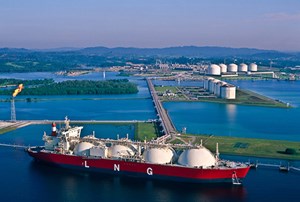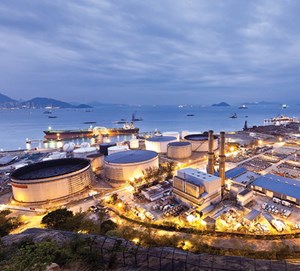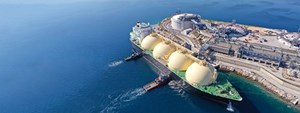How to ramp up LNG solutions to meet today and tomorrow’s challenges
The liquified natural gas (LNG) market has expanded significantly, due to increasing demand for lower carbon fuels and lack of resource availability. Furthermore, global gas supply routes have changed significantly in recent months because of global events and, as such, has accelerated the need for new solutions that not only address the issues of today, but also improve an LNG enterprise’s capacity to thrive through future volatility associated with demand for LNG.
North American gas is a key player in this trend, because of the fracing revolution, enabling the surplus of natural gas, combined with mature infrastructure and a growing network of LNG export terminal. Many of these are either under, or approved for, construction, primarily in the Gulf Coast region and Pacific Northwest.
LNG production and transport (Fig. 1) is important to long-term greenhouse gas (GHG) reduction plans because of LNG’s role as a “transition” fuel between current coal-based power generation and future renewables-based power. Several global regions have put greater reliance on LNG and natural gas as part of their national GHG reduction initiatives, with plans to gradually phase in other lower-emission commodities, such as hydrogen produced from renewable sources.

Moving quickly is important right now, but so is the need to ensure any capital projects are also relevant in a future that is transitioning to even lower carbon energy products.
Honeywell is working with LNG producers to help them ramp up production while retaining the flexibility to adapt to future needs. Honeywell can share successful practices they are seeing during this unique time, including Honeywell’s LEAP™ lean project execution methodology and optimization through built-in remote operations and autonomous control from day one.
TAKING A LEAP INTO THE FUTURE
Honeywell’s LEAP™ lean project execution methodology simplifies a project’s critical path, reduces project schedules, and supports modular construction. LEAP is an award-winning lean project execution methodology—it enhances project implementation services with innovative, enabling technologies, like Universal I/O cabinets, virtualization, cloud engineering and auto-device commissioning.
Historically, projects have been sequential—each step starts after the previous step completes. The goal of LEAP is to decouple project elements, enabling project steps to be accomplished in parallel. Core elements of the LEAP program are virtual engineering in the cloud, virtualizing of complete systems, and universal I/O.
By virtualizing systems in the cloud, companies enable global engineering collaboration. Virtualization eliminates the need to purchase duplicate computer and controller hardware at the various geographical engineering locations. Applications are designed and configured (including verification of logic, algorithms and proper I/O configuration) in a virtual environment, without having field hardware. This process removes the dependency between the functional and physical design. Engineering in a secure cloud environment allows experts across the globe to configure and debug logic and algorithms early in the project timeline, which lowers travel expenses.
Universal I/O modules feature 32 universal channels per module. Each channel can be individually configured by software for analog in, analog out, digital input or digital output. The analog points support the HART 7 protocol. Because Experion® Universal Process I/O is software-programmable, it can be shipped to the project site and configured onsite. Universal points may justify the decreased number of installed spare points per panel, which is a typical requirement in many project specifications. Customers who fully embrace the Universal I/O concept can gain large benefits by eliminating marshalling cabinets.
LEAP is augmented with even more flexibility, with Experion PKS HIVE. A large capital project can realize up to 30% capital savings in automation infrastructure projects and flexibility for up to a 25% improvement in schedule.
COMPLETE PORTFOLIO OF PROCESS SOLUTIONS
Based on a century-and-a-half of experience in the natural gas industry, Honeywell offers a complete portfolio of flexible and cost-effective process solutions for LNG production to help operators reduce risk, reliably meet end-product specifications, and earn greater returns. Honeywell UOP’s natural gas contaminant removal technologies are the industry standard, pre-treating a large percentage of the world’s LNG.
Honeywell UOP’s LNG pre-treatment processes and equipment (Fig. 2) have been deployed successfully, both offshore and onshore, including baseload, mid-scale, small-scale and floating LNG (FLNG) operations. The Honeywell UOP Ortloff process plants for natural gas liquid (NGL) and liquefied petroleum gas (LPG) recovery are recognized worldwide as industry-leading cryogenic processes for gas liquids recovery. Honeywell UOP’s SeparSIV technology can solve challenges related to heavy hydrocarbon freezing encountered in lean U.S. pipeline feed gas while significantly reducing CAPEX and OPEX.

In 2008, Honeywell expanded the benefits of the classic Main Automation Contract (MAC) to create I-MAC, offering an integrated process, operations and business readiness strategy to existing MAC projects. This provided our customers with the ability to define their work processes, from field operator and maintenance rounds to the control room and the operations workflows to the business and supply chain decisions. I-MAC offers not just integrated advanced applications, but also the capacity to enable digital transformation for gas liquefaction companies.
A three-dimensional approach. Honeywell’s focus with its Integrated I-MAC concept is to provide value and operational readiness, from the early stages of a project through the operational phase of the plant. I-MAC is a three-dimensional approach that includes flawless project execution and completion, startup readiness (which includes both operational and business readiness), planning for the full operational lifecycle and sustainable business benefits.
Operational readiness simply means that startup time is reduced significantly, and maximum production efficiency is reached as soon as possible, maximizing the return on investment for the project. This maximum production is achieved through a reduction of unplanned incidents, an increase in safety and early implementation of APC, and the application of simulation technology. Business readiness enables optimized decision-making. A holistic approach to security means not just the security of the process through the implementation of an integrated approach to safety—It also means a safety-minded approach to plant asset management and integration of physical and plant security.
Rather than trying to move in on the scope of what EPC contractors have traditionally delivered, Honeywell’s goal is to help EPC contractors and owner-operators achieve their objectives more quickly, which are to finish a project successfully and efficiently. Honeywell’s experience with the operator, particularly in terms of providing asset information through its Plant Asset Management (PAM) solutions and built-in procedure management, provide a good foundation for a smooth transition to operations upon project completion.
RAMPING UP THE PROCESS THROUGH VIRTUALIZATION
The Highly Integrated Virtual Environment (HIVE) takes the process to the next step, integrating critical functions to speed up implementation of construction modules, enabling remote operations, and improving facility uptime through more resilient infrastructure.
Virtualization is a technology that Honeywell has fully adopted, and it leads the industry with an innovative approach to industrial automation. This technology removes the need for physical computers to be dedicated hosts for an application. A virtual machine (VM) is created when the software contents of a physical computer are encapsulated into a standalone file. These VMs can then be hosted on a physical server with multiple other VMs.
This approach can reduce the computer hardware footprint of a control system by as much as 80%. This significantly reduces the cost and effort to keep physical computers updated with the latest processors and operating systems. This is extended when blade technology is introduced, to deliver a Premium Platform for Experion Virtualization Solutions. This platform will stabilize operating systems and applications for as long as eight years, while at the same time improving availability of the virtual machines.
As we look into the future, we see this technology being used to deliver products as appliances with a default pre-configuration. It is also anticipated that system upgrades will be made extremely simple with this technology. A system can be copied and loaded on an offline system, where the upgrade to a new release can occur. This offline system can be fully tested in simulation mode. Once the new version of software has been tested, the new version can be copied to the server and turned on while the old version is turned off. If a problem is identified in the new version, it can simply be turned off, and the old version turned back on. This will significantly reduce the risk in doing an upgrade on process.
It is believed that this capability will lend itself to centralized engineering teams supporting multiple manufacturing sites, as well as sites with multiple systems. The remote accessibility of virtualization is significant. The future will not require experts to be onsite to assist in troubleshooting a problem. A remote expert can view the system in a “cloud” and offer input or do engineering work. This also lends itself to the virtual Factory Acceptance Test. Instead of bringing all project engineers to the system, this technology can bring the system to the engineers.
WHAT IS A DIGITAL TWIN?
Optimization is promoted through built-in remote operations and autonomous control from the day the plant is built, including digital twin technology, where a virtual image allows for the manipulation of a physical object or process. This is supported further by processes, such as AI-based real-time optimization of everything from production to the supply chain itself.
Modern digital twins are accurate digital replications of physical objects or processes, to provide new insights into behavior and performance. For engineering project applications, the digital twin begins as a future representation of the physical process, which enables insights, decisions and actions that will lead to the desired capabilities and performance of a future state.
When a digital twin is synchronized with its real-world counterpart, it can provide a near real-time replication of current conditions, providing applicable insights that may be otherwise unknown. Extending the application to the past, a digital twin that accurately reflects the state of an asset at a prior point in time can provide useful information to understand the decisions and actions which led to the current state.

SPEED UP PRODUCTION, IMPROVE RELIABILITY, AND EXPAND CAPACITY
Industrial companies are preparing for the future, by aligning with global sustainability goals while still providing their customers with the technologies they need today. Improving LNG asset construction and LNG production processes (Fig. 3) are the first steps toward achieving those goals, without sacrificing efficiency or performance. While sourcing a provider that can offer a range of solutions to improve absolute production of LNG and marketable commodities—as well as improving production reliability and decreasing costs—can be a challenge, we at Honeywell are ready to engage with you and review the benefits and opportunities your unique project provides. WO


